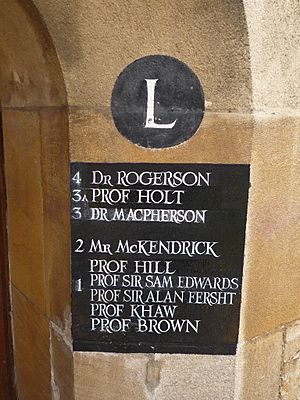Christine Holt facts for kids
Quick facts for kids
Christine Holt
|
|
|---|---|
| Born |
Christine Elizabeth Holt
28 August 1954 |
| Alma mater | BSc in biological sciences, University of Sussex; PhD in zoology, King's College, London University |
| Spouse(s) | W.A. Harris |
| Awards | Elected Member of EMBO (2005), Fellow of the Academy of Medical Sciences (2007), Fellow of the Royal Society (2009), Remedios Caro Almela Prize in Developmental Neurobiology (2011), Champalimaud Foundation Vision Award (2016), Rosenstiel Award (2022) |
| Scientific career | |
| Fields | Neuroscience |
| Institutions | Professor of Developmental Neuroscience, University of Cambridge |
Christine Elizabeth Holt (born August 28, 1954) is a British scientist who studies how brains develop. She is a Professor of Developmental Neuroscience at the University of Cambridge.
Professor Holt is famous for her work on how the brain gets "wired up." This means how brain cells, called neurons, connect to each other in very specific ways. Her research helps us understand how our brains become so complex.
Her discoveries could lead to new ways to help people with nerve damage or brain development problems.
Contents
Becoming a Scientist
Christine Holt started her science journey at the University of Sussex. In 1977, she earned her first degree in biological sciences.
She then went to King's College London for her PhD. She studied zoology and finished her PhD in 1982.
After her PhD, she worked as a researcher at Oxford University and the University of California San Diego (UCSD). She studied how the visual system (eyes and brain connections for sight) develops in frogs.
In 1986, she became a lecturer at UCSD. She continued to research how frog eyes connect to their brains when they are very young.
Important Discoveries
In 1989, Professor Holt joined the faculty at UCSD. She focused on how cells from the eye's retina grow and connect with specific brain cells. She studied special "adhesion molecules" that help cells stick together and guide these connections.
She looked at how certain molecules, like N-cadherin and integrins, help guide nerve cells. These molecules are like tiny signposts that tell growing nerve fibers where to go.
In 1997, she moved to Gonville & Caius College at the University of Cambridge. Since 2003, she has been a Professor of Developmental Neuroscience there.
She has received many important awards for her work. These include being elected a member of the European Molecular Biology Organization in 2005 and a fellow of the Royal Society in 2009. In 2022, she received the Rosenstiel Award, and in 2023, The Brain Prize. These awards show how important her research is to understanding the brain.
How Brains Get Wired
Professor Holt's early research looked at how cells move when an eye develops in frogs. Her very first important paper was published in the famous science magazine Nature in 1980.
Much of what we know today about how nerve cells from the eye connect to the brain comes from her work.
Guiding Nerve Cells
Today, her research still focuses on how nerve fibers, called axons, find their way and make connections, called synapses, to build complex brain networks.
Professor Holt was one of the first to suggest that proteins are made and broken down right at the tip of a growing axon. This process is super important for nerve cells to grow in the correct direction and make accurate connections.
She has studied how different molecules, like ephrins, netrin-1, and laminin-1, act as guides for growing axons. For example, netrin-1 can either attract or push away different types of axons, helping them find their correct paths.
Currently, Professor Holt is working with other scientists to study tiny molecules called microRNAs. They are looking at how these molecules help axons regrow and how they might be linked to certain brain conditions.
Personal Life
Christine Holt is married to W.A. Harris, who is also a respected scientist. Besides her work, she enjoys wildlife, walking, music, and spending time with her family.


